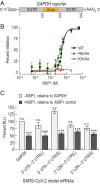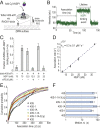Dynamic competition between SARS-CoV-2 NSP1 and mRNA on the human ribosome inhibits translation initiation
- PMID: 33479166
- PMCID: PMC8017934
- DOI: 10.1073/pnas.2017715118
Dynamic competition between SARS-CoV-2 NSP1 and mRNA on the human ribosome inhibits translation initiation
Abstract
Severe acute respiratory syndrome coronavirus 2 (SARS-CoV-2) is a beta-CoV that recently emerged as a human pathogen and is the causative agent of the COVID-19 pandemic. A molecular framework of how the virus manipulates host cellular machinery to facilitate infection remains unclear. Here, we focus on SARS-CoV-2 NSP1, which is proposed to be a virulence factor that inhibits protein synthesis by directly binding the human ribosome. We demonstrate biochemically that NSP1 inhibits translation of model human and SARS-CoV-2 messenger RNAs (mRNAs). NSP1 specifically binds to the small (40S) ribosomal subunit, which is required for translation inhibition. Using single-molecule fluorescence assays to monitor NSP1-40S subunit binding in real time, we determine that eukaryotic translation initiation factors (eIFs) allosterically modulate the interaction of NSP1 with ribosomal preinitiation complexes in the absence of mRNA. We further elucidate that NSP1 competes with RNA segments downstream of the start codon to bind the 40S subunit and that the protein is unable to associate rapidly with 80S ribosomes assembled on an mRNA. Collectively, our findings support a model where NSP1 proteins from viruses in at least two subgenera of beta-CoVs associate with the open head conformation of the 40S subunit to inhibit an early step of translation, by preventing accommodation of mRNA within the entry channel.
Keywords: NSP1; SARS-CoV-2; eukaryotic translation initiation; human ribosome; single-molecule fluorescence.
Copyright © 2021 the Author(s). Published by PNAS.
Conflict of interest statement
The authors declare no competing interest.
Figures







Similar articles
-
The differential effect of SARS-CoV-2 NSP1 on mRNA translation and stability reveals new insights linking ribosome recruitment, codon usage, and virus evolution.Nucleic Acids Res. 2025 Mar 20;53(6):gkaf261. doi: 10.1093/nar/gkaf261. Nucleic Acids Res. 2025. PMID: 40193709 Free PMC article.
-
Nonstructural Protein 1 of SARS-CoV-2 Is a Potent Pathogenicity Factor Redirecting Host Protein Synthesis Machinery toward Viral RNA.Mol Cell. 2020 Dec 17;80(6):1055-1066.e6. doi: 10.1016/j.molcel.2020.10.034. Epub 2020 Oct 29. Mol Cell. 2020. PMID: 33188728 Free PMC article.
-
Structural basis for translational shutdown and immune evasion by the Nsp1 protein of SARS-CoV-2.Science. 2020 Sep 4;369(6508):1249-1255. doi: 10.1126/science.abc8665. Epub 2020 Jul 17. Science. 2020. PMID: 32680882 Free PMC article.
-
I(nsp1)ecting SARS-CoV-2-ribosome interactions.Commun Biol. 2021 Jun 10;4(1):715. doi: 10.1038/s42003-021-02265-0. Commun Biol. 2021. PMID: 34112887 Free PMC article. Review.
-
Hepatitis C Virus Translation Regulation.Int J Mol Sci. 2020 Mar 27;21(7):2328. doi: 10.3390/ijms21072328. Int J Mol Sci. 2020. PMID: 32230899 Free PMC article. Review.
Cited by
-
The emerging role of SARS-CoV-2 nonstructural protein 1 (nsp1) in epigenetic regulation of host gene expression.FEMS Microbiol Rev. 2024 Sep 18;48(5):fuae023. doi: 10.1093/femsre/fuae023. FEMS Microbiol Rev. 2024. PMID: 39231808 Free PMC article. Review.
-
The relationship of early- and late-onset Alzheimer's disease genes with COVID-19.J Neural Transm (Vienna). 2022 Jul;129(7):847-859. doi: 10.1007/s00702-022-02499-0. Epub 2022 Apr 16. J Neural Transm (Vienna). 2022. PMID: 35429259 Free PMC article. Review.
-
Understanding COVID-19 Pathogenesis: A Drug-Repurposing Effort to Disrupt Nsp-1 Binding to Export Machinery Receptor Complex.Pathogens. 2021 Dec 17;10(12):1634. doi: 10.3390/pathogens10121634. Pathogens. 2021. PMID: 34959589 Free PMC article.
-
The N-terminal domain of SARS-CoV-2 nsp1 plays key roles in suppression of cellular gene expression and preservation of viral gene expression.Cell Rep. 2021 Oct 19;37(3):109841. doi: 10.1016/j.celrep.2021.109841. Epub 2021 Sep 30. Cell Rep. 2021. PMID: 34624207 Free PMC article.
-
The molecular basis of translation initiation and its regulation in eukaryotes.Nat Rev Mol Cell Biol. 2024 Mar;25(3):168-186. doi: 10.1038/s41580-023-00624-9. Epub 2023 Dec 5. Nat Rev Mol Cell Biol. 2024. PMID: 38052923 Review.
References
-
- Drosten C., et al. ., Identification of a novel coronavirus in patients with severe acute respiratory syndrome. N. Engl. J. Med. 348, 1967–1976 (2003). - PubMed
-
- Zaki A. M., van Boheemen S., Bestebroer T. M., Osterhaus A. D. M. E., Fouchier R. A. M., Isolation of a novel coronavirus from a man with pneumonia in Saudi Arabia. N. Engl. J. Med. 367, 1814–1820 (2012). - PubMed
Publication types
MeSH terms
Substances
Grants and funding
LinkOut - more resources
Full Text Sources
Other Literature Sources
Medical
Molecular Biology Databases
Miscellaneous

